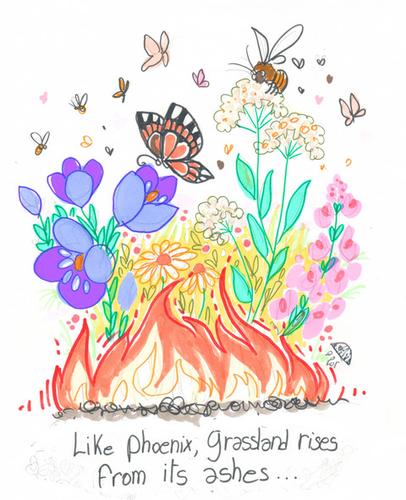当前位置:
X-MOL 学术
›
Austral Ecol.
›
论文详情
Our official English website, www.x-mol.net, welcomes your
feedback! (Note: you will need to create a separate account there.)
Burning for grassland pollination: Recently burned patches promote plant flowering and insect pollinators
Austral Ecology ( IF 1.6 ) Pub Date : 2021-09-03 , DOI: 10.1111/aec.13108 Camila da Silva Goldas 1 , Luciana Regina Podgaiski 1 , Carolina Veronese Corrêa Silva 1 , Milton de Souza Mendonça 1
Austral Ecology ( IF 1.6 ) Pub Date : 2021-09-03 , DOI: 10.1111/aec.13108 Camila da Silva Goldas 1 , Luciana Regina Podgaiski 1 , Carolina Veronese Corrêa Silva 1 , Milton de Souza Mendonça 1
Affiliation

|
Grasslands are historically and evolutionarily associated with disturbances, such as fire, that drive biodiversity assembly patterns and biotic interactions. Disturbance suppression in fire-prone ecosystems usually leads to a decline in forb diversity and flowering due to biomass accumulation, which could jeopardise pollinator diversity. In this study, we investigated patterns and drivers of plant flowering and flower insect visitor communities in a chronosequence of patches from different time-since-fire categories in Southern Brazilian grasslands. Old-burnt patches (more than 2 years since fire) had taller vegetation, more biomass and grass cover than intermediate (about 1 year after fire) and freshly-burnt patches (less than 6 months since fire), which had increased bare soil cover. Forb flower abundance was much higher in freshly burnt patches, directly predicted by the degree of habitat openness. Pollinator insects were then benefited by floral resource aggregation in freshly burnt patches, increasing in abundance (bees and butterflies) and species richness (bees). Beetle communities were positively influenced by vegetation height. Furthermore, plant species flowering and bee species composition varied between freshly and old-burnt grasslands, with indicator species found for all recovery stages but mainly freshly-burnt patches. Altogether, these results indicate the importance of maintaining freshly-burnt patches in the grassland landscape: it helps to sustain flower diversity, pollination services and flowering plant reproduction. Our findings support the idea that a mosaic of grasslands from different times-since-fire should be considered for grassland conservation.
中文翻译:

燃烧草地授粉:最近烧毁的斑块促进植物开花和昆虫传粉
草原在历史和进化上都与驱动生物多样性聚集模式和生物相互作用的火灾等干扰有关。易火灾生态系统中的干扰抑制通常会导致由于生物量积累而导致杂草多样性和开花的下降,这可能会危及传粉媒介的多样性。在这项研究中,我们调查了巴西南部草原上不同火灾时间类别的斑块时间序列中植物开花和花卉昆虫游客群落的模式和驱动因素。旧烧斑块(火灾后 2 年以上)比中间(火灾后约 1 年)和新燃烧斑块(火灾后不到 6 个月)具有更高的植被、更多的生物量和草覆盖,后者增加了裸露的土壤覆盖. 在新烧的斑块中,紫苏花的丰度要高得多,生境开放程度直接预测。然后,传粉昆虫受益于新烧斑块中的花卉资源聚集,数量增加(蜜蜂和蝴蝶)和物种丰富度(蜜蜂)。甲虫群落受到植被高度的积极影响。此外,植物物种开花和蜜蜂物种组成在新烧和旧烧草原之间存在差异,在所有恢复阶段都发现了指示物种,但主要是新烧斑块。总而言之,这些结果表明了在草原景观中保持新烧斑块的重要性:它有助于维持花卉多样性、授粉服务和开花植物的繁殖。我们的研究结果支持这样一种观点,即应考虑将来自不同时期的草原马赛克用于草原保护。
更新日期:2021-09-03
中文翻译:

燃烧草地授粉:最近烧毁的斑块促进植物开花和昆虫传粉
草原在历史和进化上都与驱动生物多样性聚集模式和生物相互作用的火灾等干扰有关。易火灾生态系统中的干扰抑制通常会导致由于生物量积累而导致杂草多样性和开花的下降,这可能会危及传粉媒介的多样性。在这项研究中,我们调查了巴西南部草原上不同火灾时间类别的斑块时间序列中植物开花和花卉昆虫游客群落的模式和驱动因素。旧烧斑块(火灾后 2 年以上)比中间(火灾后约 1 年)和新燃烧斑块(火灾后不到 6 个月)具有更高的植被、更多的生物量和草覆盖,后者增加了裸露的土壤覆盖. 在新烧的斑块中,紫苏花的丰度要高得多,生境开放程度直接预测。然后,传粉昆虫受益于新烧斑块中的花卉资源聚集,数量增加(蜜蜂和蝴蝶)和物种丰富度(蜜蜂)。甲虫群落受到植被高度的积极影响。此外,植物物种开花和蜜蜂物种组成在新烧和旧烧草原之间存在差异,在所有恢复阶段都发现了指示物种,但主要是新烧斑块。总而言之,这些结果表明了在草原景观中保持新烧斑块的重要性:它有助于维持花卉多样性、授粉服务和开花植物的繁殖。我们的研究结果支持这样一种观点,即应考虑将来自不同时期的草原马赛克用于草原保护。





















































 京公网安备 11010802027423号
京公网安备 11010802027423号